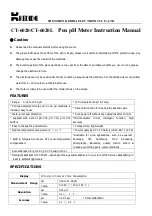
02/ 2016
BENNING MM 6-1/ 6-2
28
8.6 Capacitance measurement
Discharge capacitors fully before measurement! Never apply
voltage to the sockets for capacitance measurement as this
may cause irreparable damage to the unit. A damaged unit may
represent an electrical hazard!
- With the rotating switch
, select the desired function (
) on the
BENNING MM 6-1/ MM 6-2.
- Determine the polarity of the capacitor and discharge it completely.
- Connect the black safety measuring lead to the COM socket
on the
BENNING MM 6-1/ MM 6-2.
-
Connect the red safety measuring lead to the socket
on the
BENNING MM 6-1/ MM 6-2.
- Contact the discharged capacitor with the safety measuring leads observing
correct polarity. Read the measurement value on the digital display
of the
BENNING MM 6-1/ MM 6-2.
See fig. 9:
Capacity measurement
8.7 Frequency measurement
- Use the rotary switch
9
to select the desired function ( , Hz) of the
BENNING MM 6-1 or the function ( Hz or Hz) of the BENNING MM 6-2.
- Connect the black safety measuring lead to the COM socket
on the
BENNING MM 6-1/ MM 6-2.
- For frequency measurement in the voltage range, connect the red safety
measuring lead to the jack
of the BENNING MM 6-1/ MM 6-2 and press
the key (blue)
4
to switch over to frequency mea surement (Hz).
- For frequency measurement in the current range, connect the red safety
measuring lead to the jack
L
of the BENNING MM 6-2 and press the key
(blue)
4
to switch over to frequency measurement (Hz).
- Remember the minimum sensitivity for frequency measurements using the
BENNING MM 6-1/ MM 6-2!
-
Contact the measuring points with the safety measuring leads
and read the measurement result on the digital display
on the
BENNING MM 6-1/ MM 6-2.
See fig. 10:
Frequency measurement
8.8 Temperature measurement
(BENNING MM 6-1)
-
With the rotating switch
, select the desired function ( ) on the
BENNING MM 6-1
- Press the blue key
4
to switch over to °F or °C.
- Connect the temperature sensor (type K) to the COM jack
and to the jack
observing correct polarity.
- Place the contact point (end of the sensor lead) on the point to be
measured. Read the measurement value on the digital display
of the
BENNING MM 6-1.
See fig. 11:
Temperature measurement
8.9 Voltage indicator
The voltage indicator function is not intended for testing the
absence of voltage. Even without an indication or acoustic
signal, a dangerous contact voltage might be applied. Electrical
danger!
- With the rotating switch
9
, select the desired function (VoltSense) on the
BENNING MM 6-1/ MM 6-2.
- Press the blue key
4
to switch over to Hi (high sensitivity) or Lo (low sensi-
tivity).
- The voltage indicator function does not need any measuring lines (non-
contact detection of an alternating field). The detector is located on the top
side of the BENNING MM 6-1/ MM 6-2. In case of a phase voltage being
localized, an acoustic signal is emitted and the red LED
N
on the top side
of the device lights. An indication is shown in earthed AC mains only!
Practical hint:
Interruptions (cable breaks) in cables lying around openly such as e.g. cable
reels, fairy lights etc. can be traced from the feeding point (phase) to the point
of interruption.
Functional range: ≥ 230 V
See figure 12: Voltage indicator with buzzer
8.9.1 Phase test
- With the rotating switch
9
, select the desired function (VoltSense) on the
BENNING MM 6-1/ MM 6-2.
- Press the blue key
4
to switch over to Hi (high sensitivity) or Lo (low sensi-
















































